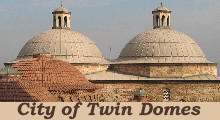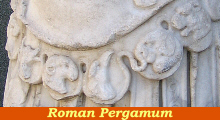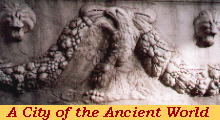

What's New!
Detailed Sitemap
All images © by Roberto Piperno, owner of the domain. Write to romapip@quipo.it. Text edited by Rosamie Moore.
Page added in March 2008.
|

 - Bursa - page two - Bursa - page two
(domes at Eski Kaplica)
The Great Mosques
Yildirim Camii
Yildirim Camii was the first mosque in Bursa to be built following a "T" plan.
Yildirim means thunderbolt, a title given to Sultan Bayezid I for his behaviour in battle. The mosque was built in 1391.
The second dome is significantly smaller than the first one as if it had been added to the original plan.
The porch is imposing and it has a very neat design which is uncommon in Ottoman art: the arches of the porch are typical of Bursa.
Yildirim Turbe
In 1400 a real thunderbolt struck the Ottoman Empire: the Central Asian warlord Timur invaded Anatolia; in the Battle of Ankara (July 20, 1402) he defeated the Ottoman army and he captured Sultan Bayezid who died one year later in captivity.
Bayezid's son Suleyman Celebi dedicated to his father this elegant tomb which was embellished by two porphyry columns. The Yildirim complex includes also a large medrese and a hospital.
Yesil Camii
The Yesil (Green) Mosque owes its name to the blue green tiles which decorate its interior and which once decorated also its domes.
It does not have a porch which was planned but never actually built. The minarets are a later addition.
Yesil Camii: details (1)
Each window has a different decoration based on flower designs and scriptures carved in marble.
Yesil Camii: details (2)
The decoration combines very elaborate details with an overall neat design.
The image used as background for this page
shows a detail of the decoration of nearby Yesil Turbe.
Yesil Medrese
The Yesil complex was built between 1419 and 1421 by Sultan Mehmet I and it included also a very large medrese.
Almost every mosque had an adjoining medrese where children
received an education which was not limited to religious matters. This school system greatly contributed to the
strength of the Ottoman society. Although we do not have data on historical levels of literacy, we can assume that the abundance of
inscriptions and scriptures indicates that they were not very low.
Orhan Camii
This mosque was built by Orhan Gazi in 1339, but it was burnt down in 1417 when Bursa was raided during a revolt of Anatolian tribes.
It was rebuilt a few years later by Sultan Mehmet I. The porch has not a very Ottoman appearance, maybe because the mosque was restored by the French architect Parvillée in 1864 after it had been damaged by an earthquake in 1855.
Ulu Camii
This great mosque was built by Sultan Bayezid I to celebrate his 1396 victory against a Christian army
which tried to contain the Ottoman expansion in Europe. It was burnt down by Timur in 1402 and rebuilt a few years later: its central hall is covered by twenty domes supported by a grid of piers. Almost all of the domes collapsed during the 1855 earthquake.
The markets
(left) Entrance to Koza Han; (right) one of the entrances to the Great Bazar
Bursa was the first Asian city along the continental Silk Road which linked Europe with China. In particular Bursa acquired a major role in the manufacturing and trade of silk.
Sultan Bayezid II built in 1490 Koza Han to provide silk merchants and their trains with meeting and resting facilities. It is still used as a market for silk drapery.
Bursa has also a large covered Carsi (market area).
Koza Han: details of the interior: (left) gallery; (right) courtyard
Move to page three or return to page one.
Clickable Map of Turkey showing all the locations covered in this website (opens in another window).

SEE THESE OTHER EXHIBITIONS (for a full list see my detailed index).
  
|